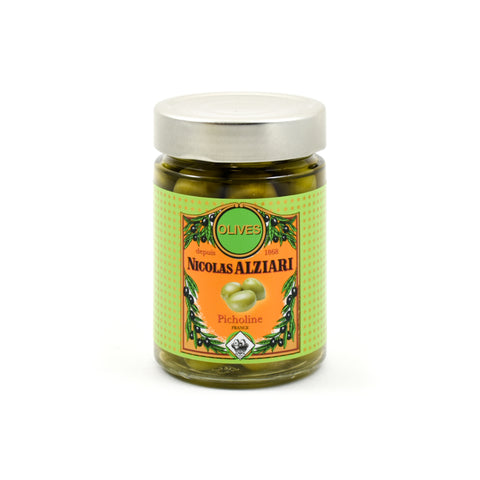The Ultimate Guide To Pitted Olives
by Ellie Edwards

Find out everything you need to know about the moreish snack with our guide to pitted olives, with tips on how to use them in your cooking and which variety to buy.
What are pitted olives?
All olives have stones (also known as pits). During the processing of olives, sometimes the pits can be removed, thus creating pitted olives. There are a number of reasons why pits are removed from olives:
- Once the pits are removed, olives can be stuffed with other ingredients. Most common is almonds, garlic, sundried tomatoes and anchovies
- Pitted olives are ready to be used in cooking, especially if you want to slice the olives for topping a pizza, stirring through puttanesca pasta or garnishing a martini
- Making tapenade from scratch is easier if you use pitted olives. They are ready to blitz with capers, anchovies, olive oil and red wine vinegar
Are pitted olives good for you?
Olives are about 80% water, and around 10-15% fat. The fat is monounsaturated - a good kind of fat which has many associated health benefits. These include lowering bad cholesterol, which in turn reduces the risk of heart disease.
Olives also contain many micronutrients, the main one being vitamin E. Vitamin E is an antioxidant which helps fight off infection. While olives have many good health properties, when preserved in brine, the quantity of salt increases.
The recommended amount of salt per day is 6g, and on average, 5 olives contain 0.5g salt.
What’s the difference between pitted olives and other olives?
The only difference between pitted olives and other olives is the removal of the stone from the centre.
The difference between green and black olives is when they are picked:
- Green olives are picked at the start of the harvest (typically September) and have a nutty flavour and plump, firmer texture.
- Black olives are harvested at the end of the season (November and December) and have a softer flesh and often deeper and more mellow flavour. .
Both green and black olives can be pitted.
What are the different varieties of olives?
Whether you’re after a spicy kick, something sweeter or prefer to keep it classic, we’ve explained the different flavour profiles of various olive varieties. Plus, how to use each type.

Gordal olives
Gordal olives are grown in Spain. The bright green olives have a firm, crisp texture. Gordal translates as ‘the big one’ which accurately describes the plump nature of these olives.
Manzanilla olives
Manzanilla olives are traditionally grown in Seville. The plump, green olive is often stuffed with other ingredients including almonds, tomatoes and even mozzarella cheese. Adding extra ingredients gives another flavour and texture profile to the stone fruit.
Almonds add extra bite, providing a wonderful contrast to the meaty Manznailla olive. Enjoy these studded olives straight from the jar, or serve alongside slices of salty cheese.
Kalamata olives
Kalamata olives are named after the city of Kalamata in the southern Peloponnese, Greece. They have a rich purple hue and a meaty texture.
Kalamata olives are oblong in shape. When fresh, they are quite bitter, however preserving processes can alter the final flavour, the most common of which involves soaking the olives in brine.
Castelvetrano olives
Castelvetrano olives come from Castelvetrano, Sicily. The bright green olives are picked while they are young, resulting in a sweet, buttery flavour and firm texture.
Picholine olives
Picholine olives are small and green. The olives originated in Gard, southern France, however they are now grown in Morocco, Chilli, Israel and the USA. Picholine olives are often used for garnishing cocktails, as well as being pressed and made into oil.
Picholine olives pair well with brie, artichokes and prosciutto on antipasti platters. Crush the green olives into a coarse paste for a mild tapenade to serve with goats' cheese. Picholine olives are also an ideal, crisp garnish for a Martini cocktail.
Nyon olives
Nyon olives were originally grown in southern France. The small, shiny, black olives have a salty bitterness and are usually cured in olive oil.
Gaeta olives
Gaeta olives are small black Italian olives. The super fruity olives have notes of blackcurrant. Try using a tapenade or pair with salty blue cheese.
Beldi olives
Beldi olives are harvested in Morocco. They have a distinctive, wrinkled skin and a chewy texture. The intense flavour works well in tagines, or adding a spicy kick to salads.
Niçoise olives
Cailletier olives from the Cote d’Azur, also known as Niçoise olives, are small beige to dark brown olives that are popularly used in that classic dish Salade Niçoise. They have a nutty, bitter flavour.
Cailletier olives have a rich flavour, yet are also quite sharp. Alziari pack them in brine with thyme and bay, adding subtle herbal notes. Serve with cheese and cold meats, pit and use for pizzas or pissalidiere or simply as table olives with aperitifs.
How about pitting olives myself?
It’s easy to pit olives yourself, you just need a nifty utensil that’ll do the work for you!
Make light work of pitting olives with this stainless steel kitchen utensil. Simply place the olive in the oval-shaped cup, then clamp together to remove the pit. This is great for when you want to make fresh tapenade.
Feeling inspired? Check out our full range of olives, and read our guide to choosing olive oil.

About the author
Ellie Edwards is a food writer for Sous Chef. Previously she worked at olive magazine, writing about exciting new ingredients, UK restaurants and travelling the world to find the best cinnamon buns. When she's not exploring the likes of Belize, Kerala and Zanzibar, Ellie loves rustling up a feast in her London kitchen, with a particular passion for porridge, sourdough and negronis.








